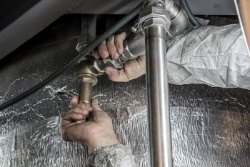Canada’s Emphasis On Infrastructure Delivery Provides Us Lessons
Canada delivers a new hospital or healthcare facility every six months. “That’s not a dream; that’s consistent delivery over a couple of decades and a lesson New Zealand needs to learn,” says Infrastructure New Zealand Chief Executive Nick Leggett.
Toronto’s health infrastructure delivery is one of the standout takeaways from Infrastructure New Zealand’s just-released report, Building Strong Foundations: Canadian System Design and Infrastructure Delivery, following a high-level industry delegation to Toronto, Ottawa and Montréal in May.
“Canada isn’t perfect when it comes to delivering infrastructure, but unlike New Zealand they’ve stopped chasing perfection,” says Leggett. “Instead, they prioritise consistent delivery, ongoing improvements and progress, and the benefits of infrastructure across the lifetime of the asset. It’s a mindset shift New Zealand must embrace.”
“Canada has shown what’s possible when you maintain a credible and enduring pipeline of infrastructure projects. This consistency allows their industry to plan, invest and retain a skilled workforce – something New Zealand continues to struggle with due to the stop-start nature of our infrastructure planning.”
“After years of inconsistent investment and political priorities, our own infrastructure sector is struggling. Firms that have experienced a downturn in activity can’t just switch capacity on like a tap.”
“While there are positive signals from the Government with $6 billion worth of upcoming projects, we need a more certain long-term pipeline of work to support capability and capacity within the infrastructure workforce.”
Advertisement - scroll to continue reading“Canada is also far better at selecting the procurement model that best fits the project. It’s less ideological, more pragmatic – focused on what works.”
“Having a proper pipeline, like in healthcare, means Canadian providers can streamline delivery and gain efficiencies. Their approach focuses on de-risking early, collaborating across sectors and celebrating what infrastructure delivers for people – not just how much it costs.”
“In Canada, infrastructure is seen as nation-building – not just a line item. It’s about growing the economy, building climate resilience and improving lives,” says Leggett. “It’s time we told this story in New Zealand.”
Key insights from the report include:
- Canada completes a new hospital every six months – with a focus on people, outcomes and speed.
- Delivery models are flexible and pragmatic, not ideological.
- Lifecycle value and performance matter more than lowest upfront cost.
- Political consistency, institutional maturity, and Indigenous partnerships underpin delivery success.
The delegation’s findings call for New Zealand to develop a national infrastructure vision, reform procurement culture, and create a dedicated delivery agency to build capability and investor confidence.
“New Zealand can’t afford to keep doing things the same way if we want to get better value from our infrastructure spend. This report is a blueprint for bolder infrastructure leadership,” says Leggett.
“So, let’s stop talking and arguing, and instead focus on delivering the infrastructure New Zealanders need – consistently, and for the long term.”
Building Strong Foundations: Canadian System Design and Infrastructure Delivery - Summary Report is available at https://infrastructure.org.nz/wp-content/uploads/2025/07/Infrastructure-NZ-International-Delegation-Canada-Summary-Report25-Digital-Single-Pages.pdf
Note:
Full report here.
Infrastructure New Zealand is Aotearoa’s peak membership organisation for the infrastructure sector. We promote best practice in national infrastructure development through research, advocacy, and public and private sector collaboration. We promote public and media discussion on issues of importance to the infrastructure sector. Our membership is comprised of around 140 organisations, including government agencies, consultants, contractors, financiers, utilities, and academics. These organisations employ approximately 150,000 people in infrastructure-related roles and are united in their commitment to creating a better New Zealand through outstanding infrastructure.


 Commerce Commission: ComCom Finds No Evidence Of Cartel Behaviour In Banks’ Involvement In Net-Zero Banking Alliance
Commerce Commission: ComCom Finds No Evidence Of Cartel Behaviour In Banks’ Involvement In Net-Zero Banking Alliance Hāpai te Hauora: Pātea - A World-First Māori Gambling Harm Digital Platform Launches Across Aotearoa
Hāpai te Hauora: Pātea - A World-First Māori Gambling Harm Digital Platform Launches Across Aotearoa Āti Awa Toa Hauora Iwi Māori Partnership Board: New Whaitua Mapping Tool And Monitoring Our Oranga Framework Places Health Information In Whānau Hands
Āti Awa Toa Hauora Iwi Māori Partnership Board: New Whaitua Mapping Tool And Monitoring Our Oranga Framework Places Health Information In Whānau Hands Hugh Grant: How You Know You Need To Get Your Business's Plumbing Checked
Hugh Grant: How You Know You Need To Get Your Business's Plumbing Checked Bill Bennett: Download Weekly—Winter, game updates see UFB traffic surge
Bill Bennett: Download Weekly—Winter, game updates see UFB traffic surge Science Media Centre: Is Gene Editing The Next Frontier Of Conservation? – Expert Reaction
Science Media Centre: Is Gene Editing The Next Frontier Of Conservation? – Expert Reaction


